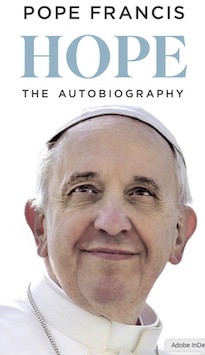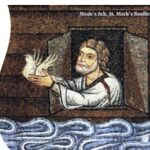Pope Francis’ amazing election as Pope Francis I in 2013
The following is a summary of the ‘amazing’ events
associated with the Election of Pope Francis in 2013
Quotes are from Pope Francis’ autobiography. “HOPE: The Autobiography”
Conclave for election of Pope Francis
Commenced Tuesday, 12th March 2013. The conclave held its first vote that evening.
Pope Francis’s words from his autobiography (HOPE) are as follows:
“I had some votes but was well aware they were stop-gap votes.
“On the following morning, Wednesday, the 13th, at the second ballot, I still had ‘stop-gap’ votes.
On the third ballot, there were a few more. . . .
After the black smoke, I moved towards the refectory for lunch, but went first to find Jaime Lucas Ortega, archbishop of Havana, who had asked if I could bring him the text of the speech I had given to the general congregations. There was nothing in writing, so I briefly reconstructed what I had said, in four points: (The four points are listed below)
The Archbishop of Havana said: “Oh, thank you, I now have a memento of the pope to take home with me.”
I still thought it was a joke.
“The FOUR POINT (the text of the speech I had given to the general congregations)
Introduction:
Reference is made to evangelization. It is the Church’s reason for being.
“The sweet and comforting joy of evangelizing” (Pope Paul VI).
It is Jesus Christ himself who urges us from within.
- Evangelizing presupposes apostolic zeal.
Evangelizing presupposes a desire in the Church to come out of herself.
The Church is called to come out of herself and to go to the peripheries, not only geographically, but also the existential peripheries: the mystery of sin, of pain, of injustice, of ignorance and indifference to religion, of intellectual currents, and of all misery. - When the Church does not come out of herself to evangelize, she becomes self-referential and then gets sick Pope Francis with the phrase ‘see the deformed woman of the Gospel according to Luke. (Luke 13:10-17 – see footnote below).
The evils that happen in ecclesiastical institutions over time have their root in self-referentiality and a kind of theological narcissism.
(i.e. an excessive interest in or admiration of oneself and one’s physical appearance)
In Revelation, Jesus says that he is at the door and knocks.
Obviously, the text refers to his knocking from the outside in order to enter …
But I think about the times in which Jesus knocks from within so that we will let him come out. The self-referential Church seeks to keep Jesus Christ within herself and does not let him out. - When the Church is self-referential, inadvertently, she believes she has her own light; she ceases to be the mysterium lunae (i.e. mystery of the moon) and gives way to that very serious evil, spiritual worldliness (which, according to de Lubac, is the worst evil that can befall the Church); which lives to give glory only to one another.
Put simply, there are two images of the Church: (A) the Church that evangelizes and comes out of herself, the Dei Verbum religiose audiens et fidenter proclamans /”the Church that religiously heeds and faithfully proclaims the word of God”], or (B) the worldly Church that lives within herself, of herself, for herself.
This should shed light on the possible changes and reforms which must be carried out for the salvation of souls. - Thinking about the next pope:
He should be a man who, from the contemplation and adoration of Jesus Christ,
(a) helps the Church to go out from herself to the existential peripheries,
(b) helps her to be the fruitful mother who gains life from “the sweet and comforting joy of evangelizing.”
Rome, March 9, 2013
Subsequent Events:
Pope Francis continues:” the elevator reached the refectory area. Several European Cardinals were sitting at a table and one place was still vatant. They called me “Come, Eminence, come and sit with us/”. They started to ask a thousand questions, of all kinds about Latin America . . .
. . . I found myself thinking: Hah, it weems like and exam … And in fact it probably was. They were examining me: It was I who hadn’t understood.
We ended our discussion, and I stood up to leave, when a Spanish-speaking cardinal approached me . . . “Do you have a lung missing?”, he asked. No , I replied, they cut away the upper lobe because I had three cysts. “ And when did it happen?” A long time ago, in 1957, I said. The cardinal turned red, uttered a swear word, and clenched his teeth: “These last-minute maneuvers!” he exclaimed.
It was then that I began to understand. I understood at least that the danger was there. . .
The fourth ballot began. “I began to hear Bergoglio, Bergoglio, Bergoglio, Bergoglio … The Brazilian cardinal Cláudio Hummes, prefect emeritus of the Congregation for the Clergy, who was sitting on my left, patted me on the back: “Do not worry, it’s the way of the Holy Spirit.” I reached 69 votes, I think, and I understood. The majority to be reached was 77 out of 115, two-thirds.
When my name was pronounced for the seventy-seventh time, there was a burst of applause, while the reading of the votes went on. I don’t know exactly how many votes there were in the end, I was no longer listening, the noise covered the voice of the scrutineer.
But at that moment, while the cardinals were still applauding, Cardinal Hummes, who had studied at the Franciscan seminary of Taquari, in Rio Grande do Sul, stood up and came to embrace me: “Don’t forget the poor,” he said.
Those words of his remained with me, I felt them in my flesh.
It was then that the name Francis appeared.
“Those words of his remained with me, I felt them in my flesh. It was then that the name Francis appeared. I had never imagined that the conclave could affect me directly, and in no way could I have thought about a name as pope.”
During the days of the conclave, a homeless man was wandering around Saint Peter’s Square with a placard around his neck. On it was written “Pope Francis I.” But that image came back to mind only many days later, when the photo appeared in several newspapers.
Footnote: Luke 13:10-17
10 On a Sabbath Jesus was teaching in one of the synagogues, and a woman was there who had been crippled by a spirit for eighteen years.
She was bent over and could not straighten up at all.
When Jesus saw her, he called her forward and said to her, “Woman, you are set free from your infirmity.”
Then he put his hands on her, and immediately she straightened up and praised God.
The synagogue leader was indignant because Jesus had healed on the Sabbath and said to the people,
“There are six days for work. So come and be healed on those days, not on the Sabbath.”
The Lord answered him, “You hypocrites!
Doesn’t each of you on the Sabbath untie your ox or donkey from the stall and lead it out to give it water? Then should not this woman, a daughter of Abraham, whom Satan has kept bound for eighteen long years, be set free on the Sabbath day from what bound her?”
When he said this, all his opponents were humiliated, but the people were delighted with all the wonderful things he was doing.


